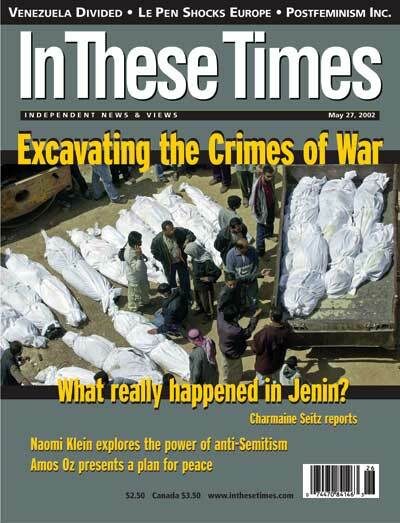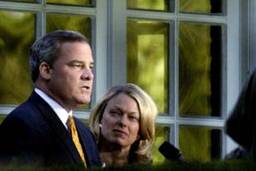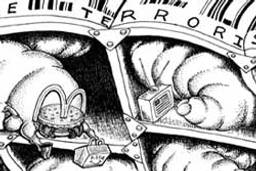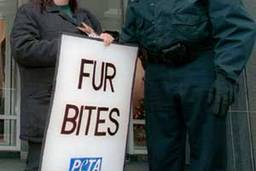
WashingtonIt was overcast and rainy here much of the April 19 to 22 weekend. But for many thousands of demonstrators antiwar and global justice movement demonstrators, it felt like spring. Better than expected turnout, and a refreshing sense of regaining momentum lost, buoyed activists spirits.
Last September 10, anti-globalization organizers were immersed in planning for end-of-the-month demonstrations against the pillars of Third World lending, the International Monetary Fund (IMF) and World Bank. They expected the largest and most militant U.S. expression of radical dissent since the Vietnam War.
The September 11 terror attacks stopped the movement in its tracks. In the new climate of fear, whipped-up patriotism and loosened restrictions on government repression, many were concerned that street protest would backfire.
Thus, Aprils protests tested the waters. The general consensus was thatdespite heavy-handed police presencethe chill is gone, and the waters fine.
Police estimated the crowd at the Saturday, April 20, rally on the mall in front of the Capitol at 75,000. Many used the term historic to describe the vast participation by Arab- and Muslim-Americansperhaps one-third or more of the crowd.
John Cavanagh, director of the Institute for Policy Studies, saw cooperation between the anti-war and global justice movements as marking a new stage. As the Seattle WTO protests marked the coalescence of single-issue activism into a broader anti-corporate movement, the weekends dissent focused on the interrelatedness of economic injustice and military oppression.
Theres a growing realization that the greatest threat to peace and stability in the world is that there are over a billion people who are poor, and the global economy has managed to make the poor poorer, Cavanagh says.
The rally was originally called to protest the Bush administrations permanent war policy, the crackdown on civil liberties and profiling of the Muslim and Arab communities. But the Mideast crisis took precedence. With a Palestinian flag draped from the side of the speakers platform billowing in the breeze, the Israeli military occupation and its underwriting by an estimated annual $5 billion in direct and indirect U.S. aid were condemned in equal measure.
While Saturdays rally was the largest event, it was not the only one. Over four days, marchers organized a teach-in, lobbying, rallies and civil disobedience in opposition to U.S. military aid to Colombia and for the closing of the School of the Americas (SOA) at Fort Benning, Georgia. Two thousand to 3,000 anti-corporate globalization protesters met weekend meetings of the IMF and World Bank for morning rallies and street theater in front of the World Bank building. And late Monday afternoon, April 22, a few thousand supporters of Palestinian rights, hemmed in on all sides by police, protested outside the Washington Hilton Hotel, where AIPAC, a pro-Israel lobbying group, was holding a conference.
There were some notes of dissonance. On at least two occasions during the weekend, the police formed cordons around peaceful demonstrators, arbitrarily containing them until police chose to back off.
The Saturday and Monday rallies demonstrated that support for the endsif not the meansof the Palestinian cause is deep on the left. But many were troubled by a small minority of speakers who advocated not peace and mutual recognition, but the destruction of Israel. When one speaker on Monday called for unconditional support for any actions taken in the name of Palestinians, some in the crowd booed.
The weekend was a success despite the fact that labor and mainstream environmental groups were not involved. And except for a couple of glaring exceptionsrival groups commandeered the stage at several rallies, for exampledisparate groups worked well together. The Enron scandal, the Argentine economic meltdown under the dictates of the IMF, the clumsy Bush administration support for the abortive coup in Venezuela, and its failure to articulate a path to peace and justice in the Mideastall combined in protesters eyes to make the administration vulnerable on the movements terms.
The inseparability of peace and economic justice was the message whether the topic was Colombia, Palestine, Afghanistan or a potential war with Iraq. Says Andy Burns, a young organizer with the National Youth and Student Peace Coalition, The fist that protects and furthers U.S. economic interests is military domination.
Last September 10, anti-globalization organizers were immersed in planning for end-of-the-month demonstrations against the pillars of Third World lending, the International Monetary Fund (IMF) and World Bank. They expected the largest and most militant U.S. expression of radical dissent since the Vietnam War.
The September 11 terror attacks stopped the movement in its tracks. In the new climate of fear, whipped-up patriotism and loosened restrictions on government repression, many were concerned that street protest would backfire.
Thus, Aprils protests tested the waters. The general consensus was thatdespite heavy-handed police presencethe chill is gone, and the waters fine.
Police estimated the crowd at the Saturday, April 20, rally on the mall in front of the Capitol at 75,000. Many used the term historic to describe the vast participation by Arab- and Muslim-Americansperhaps one-third or more of the crowd.
John Cavanagh, director of the Institute for Policy Studies, saw cooperation between the anti-war and global justice movements as marking a new stage. As the Seattle WTO protests marked the coalescence of single-issue activism into a broader anti-corporate movement, the weekends dissent focused on the interrelatedness of economic injustice and military oppression.
Theres a growing realization that the greatest threat to peace and stability in the world is that there are over a billion people who are poor, and the global economy has managed to make the poor poorer, Cavanagh says.
The rally was originally called to protest the Bush administrations permanent war policy, the crackdown on civil liberties and profiling of the Muslim and Arab communities. But the Mideast crisis took precedence. With a Palestinian flag draped from the side of the speakers platform billowing in the breeze, the Israeli military occupation and its underwriting by an estimated annual $5 billion in direct and indirect U.S. aid were condemned in equal measure.
While Saturdays rally was the largest event, it was not the only one. Over four days, marchers organized a teach-in, lobbying, rallies and civil disobedience in opposition to U.S. military aid to Colombia and for the closing of the School of the Americas (SOA) at Fort Benning, Georgia. Two thousand to 3,000 anti-corporate globalization protesters met weekend meetings of the IMF and World Bank for morning rallies and street theater in front of the World Bank building. And late Monday afternoon, April 22, a few thousand supporters of Palestinian rights, hemmed in on all sides by police, protested outside the Washington Hilton Hotel, where AIPAC, a pro-Israel lobbying group, was holding a conference.
There were some notes of dissonance. On at least two occasions during the weekend, the police formed cordons around peaceful demonstrators, arbitrarily containing them until police chose to back off.
The Saturday and Monday rallies demonstrated that support for the endsif not the meansof the Palestinian cause is deep on the left. But many were troubled by a small minority of speakers who advocated not peace and mutual recognition, but the destruction of Israel. When one speaker on Monday called for unconditional support for any actions taken in the name of Palestinians, some in the crowd booed.
The weekend was a success despite the fact that labor and mainstream environmental groups were not involved. And except for a couple of glaring exceptionsrival groups commandeered the stage at several rallies, for exampledisparate groups worked well together. The Enron scandal, the Argentine economic meltdown under the dictates of the IMF, the clumsy Bush administration support for the abortive coup in Venezuela, and its failure to articulate a path to peace and justice in the Mideastall combined in protesters eyes to make the administration vulnerable on the movements terms.
The inseparability of peace and economic justice was the message whether the topic was Colombia, Palestine, Afghanistan or a potential war with Iraq. Says Andy Burns, a young organizer with the National Youth and Student Peace Coalition, The fist that protects and furthers U.S. economic interests is military domination.
Hank Hoffman is a writer based in Connecticut.








